A Guide to Business Analytics and Intelligence Basics for Beginners
What Is Business Intelligence?
Business Intelligence is a method of analysis driven by technology that enables enterprises to examine and present data relevant to their business. Through business intelligence, companies draw from their internal data stores to arrive at business conclusions and strategies.
Tools for Building and Maintaining Business Intelligence.
Dashboards, data mining, and visualizations are examples of business intelligence tools that give decision-makers quick, pertinent insight. Experts also depend on extract, transform, and load (ETL) tools for importing data from many sources, including SQL and Excel.

What Is Business Analytics?
Processes like data mining, applied and predictive analytics, and statistics are all included in Business Analytics. Data is modelled and simulated using computer languages like Python and R to provide insights and forecast future results.
Tools for Building and Maintaining Business Analytics.
Data analysis and Data visualization are combined by a tool called visual analytics to provide information in easily understood formats like graphs. Regression analysis and scenario analysis are two more business analytics tools. With the use of these technologies, businesses may take into account a variety of factors before making judgements. Similar to a scientific experiment, a hypothesis is formed, and its validity is then determined by testing. For instance, a business can test its hypothesis using a regression analysis tool to see if a product’s pricing has an impact on product demand.
Companies can also use time series analysis, another tool, to investigate and extract pertinent data at intervals of time in order to forecast possible future outcomes. Businesses can employ text analytics to examine vast amounts of unstructured text in order to identify trends and derive valuable insights.
Steps in Business Analytics
The processes involved in the process are another crucial element to comprehend when you study the fundamentals of business analytics. The following are the steps that are involved in this process
Data Identification and Collection: Employ a variety of techniques to locate and gather pertinent data from both internal and external sources.
Data Processing and storing: It involves cleaning and integrating data to ensure data quality by removing errors and inconsistencies. It is then stored in a structured manner by converting to a standardized format for data analysis.
Data Analysis: Deriving meaningful insights by analysing data using appropriate statistical and analytical tools and techniques.
Data Visualization: Transforming complex data into visual formats such as charts, graphs and dashboards after analysing. It makes data easy to understand.
Making better decisions: Using data analytical Information to make informed business decisions, solve problems, and identify new business opportunities.







